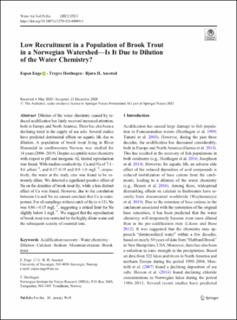Low Recruitment in a Population of Brook Trout in a Norwegian Watershed—Is It Due to Dilution of the Water Chemistry?
Peer reviewed, Journal article
Published version

Åpne
Permanent lenke
https://hdl.handle.net/11250/2724443Utgivelsesdato
2021Metadata
Vis full innførselSamlinger
- Publikasjoner fra CRIStin - NINA [2364]
- Scientific publications [1392]
Originalversjon
10.1007/s11270-020-04969-1Sammendrag
Dilution of the water chemistry caused by reduced acidification has lately received increased attention, both in Europe and North America. There has also been a declining trend in the supply of sea salts. Several studies have predicted detrimental effects on aquatic life due to dilution. A population of brook trout living in River Hunnedal in southwestern Norway was studied for 14 years (2006–2019).Despite acceptable water chemistry with respect to pH and inorganic Al, limited reproduction was found. With median conductivity, Ca and Na of 7.1– 8.6 μScm−1, and 0.17–0.19 and 0.9–1.0 mgL−1, respectively, the water at the study sites was found to be extremely dilute. We detected a significant positive effect of Na on the densities of brook trout fry, while a less distinct effect of Ca was found. However, due to the correlation between Ca and Na we cannot conclude that Ca is unimportant. For all samplings without catch of fry (n = 13), Na was 0.86 ± 0.15 mgL−1, suggesting a critical limit for Na slightly below 1 mgL−1.We suggest that the reproduction of brook trout was restricted by the highly dilute water and the subsequent scarcity of essential ions. Acidification recovery . Water chemistry . Dilution . Calcium. Sodium. Mountain streams . Brook trout
